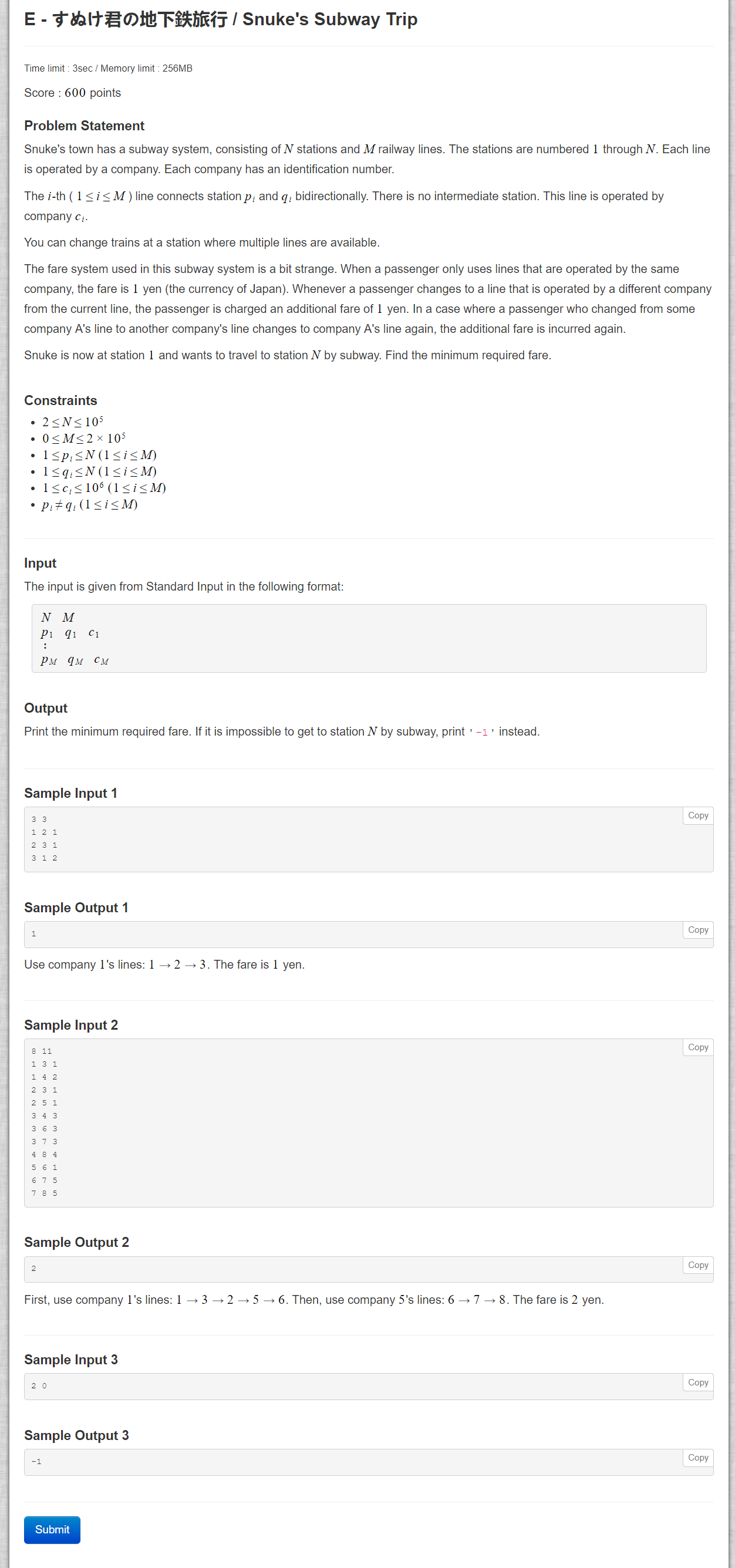(有任何问题欢迎留言或私聊 && 欢迎交流讨论哦
Catalog
Problem:传送门
原题目描述在最下面。
(n(1e5))个点, (m(2e5))条边, 每条边有一个属性值。经过一条同一属性值的连续路径花费为1。问从1到n的最小花费。
Solution:
我的解法
直接边最短路搞,然后t的飞起。仔细一想,这样写的话有(2e5)个点,边数更是多到飞起,拿命跑啊,不过代码我还是放下面。
正解:拆点
把一条(u->v)属性为(c)的路径,拆成(u->uc, uc->vc, vc->v)三条路径,边权分别为(1, 0, 1)。
然后跑最裸的最短路就行,答案除(2)输出。
why?
为什么这样是对的呢?
对于一个点连接的许多路径,从一条走向另一条,如果属性相同就不需要额外花费。这点怎么做到的呢?
比如(x->y,y->z)属性均为(c):实际路径是(x->yc->z),经过了yc这个中间点,而且没有额外的花费。
答案除(2)是因为出发和结束都算了一遍花费。
AC_Code:
#include <cstdio>
#include <iostream>
#include <cstring>
#include <string>
#include <algorithm>
#include <queue>
#include <unordered_map>
#define fi first
#define se second
#define iis std::ios::sync_with_stdio(false)
using namespace std;
typedef long long LL;
typedef unsigned long long uLL;
typedef pair<int, int> pii;
const int INF = 0x3f3f3f3f;
const int MXN = 1e6 + 5;
const int MXT = 2e7 + 6;
const uLL base = 99959;
unordered_map<uLL, int> mp;
int n, m, tn;
int head[MXN], tot;
struct lp {
int v, c, nex;
}cw[MXT];
int dis[MXT], vis[MXT], fa[MXN];
void add_edge(int u,int v,int w) {
cw[++tot].v = v;cw[tot].c = w;cw[tot].nex = head[u];
head[u] = tot;
cw[++tot].v = u;cw[tot].c = w;cw[tot].nex = head[v];
head[v] = tot;
}
void dij() {
priority_queue<pii,vector<pii>,greater<pii> >Q;
for(int i = 1; i <= n; ++i) dis[i] = INF, vis[i] = 0;
dis[1] = 0;
Q.push({dis[1], 1});
while(!Q.empty()) {
pii now = Q.top();Q.pop();
int u = now.se;
if(vis[u]) continue;
vis[u] = 1;
for(int i = head[u]; ~i; i = cw[i].nex) {
int v = cw[i].v;
//if(vis[v]) continue;
if(dis[v] > dis[u] + cw[i].c) {
dis[v] = dis[u] + cw[i].c;
Q.push({dis[v], v});
}
}
}
int ans = dis[tn];
while(!Q.empty()) Q.pop();
if(ans == INF) ans = -2;
printf("%d
", ans/2);
}
int Fi(int x) {
return fa[x] == x? x: fa[x] = Fi(fa[x]);
}
int get(int x, int y) {
uLL tmp = x;
tmp = tmp * base * base + y * base + x ^ y;
if(mp[tmp]) return mp[tmp];
mp[tmp] = ++n;
return n;
}
int main(int argc, char const *argv[]) {
while(~scanf("%d%d", &n, &m)) {
memset(head, -1, sizeof(head));
tot = -1;
mp.clear();
tn = n;
for(int i = 1; i <= n; ++i) fa[i] = i;
for(int i = 0, u, v, c, pa, pb, uc, vc; i < m; ++i) {
scanf("%d%d%d", &u, &v, &c);
pa = Fi(u), pb = Fi(v);
fa[pa] = pb;
uc = get(u, c); vc = get(v, c);
add_edge(u,uc,1);add_edge(uc,vc,0);add_edge(vc,v,1);
add_edge(v,vc,1);add_edge(vc,uc,0);add_edge(uc,u,1);
}
if(Fi(tn) != Fi(1)){
printf("-1
");
continue;
}
dij();
}
return 0;
}
TLE_code
#include <cstdio>
#include <iostream>
#include <cstring>
#include <string>
#include <algorithm>
#include <queue>
#include <unordered_map>
#define fi first
#define se second
#define iis std::ios::sync_with_stdio(false)
using namespace std;
typedef long long LL;
typedef unsigned long long uLL;
typedef pair<int, int> pii;
const int INF = 0x3f3f3f3f;
const int MXN = 1e5 + 5;
const int MXT = 4e5 + 6;
int n, m;
int head[MXN], tot;
struct lp {
int v, c, nex;
}cw[MXT];
vector<pii> mp[MXN];
int dis[MXT], vis[MXT], fa[MXN];
void add_edge(int u,int v,int w) {
cw[++tot].v = v;cw[tot].c = w;cw[tot].nex = head[u];
head[u] = tot;
cw[++tot].v = u;cw[tot].c = w;cw[tot].nex = head[v];
head[v] = tot;
}
void dij() {
priority_queue<pii,vector<pii>,greater<pii> >Q;
memset(dis, 0x3f, sizeof(dis));
memset(vis, 0, sizeof(vis));
for(int i = head[1]; ~i; i = cw[i].nex) {
dis[i] = 1;
Q.push({dis[i], i});
}
int ans = INF;
while(!Q.empty()) {
pii now = Q.top();Q.pop();
if(vis[now.se]) continue;
vis[now.se] = 1;
int u = now.se, a = cw[u].v;
if(a == n) {
ans = min(ans, dis[u]);
break;
}
for(int i = head[a]; ~i; i = cw[i].nex) {
if(vis[i]) continue;
if(dis[i]>dis[u]+(cw[i].c!=cw[u].c)) {
dis[i] = dis[u]+(cw[i].c!=cw[u].c);
Q.push({dis[i], i});
}
}
}
while(!Q.empty()) Q.pop();
if(ans == INF) ans = -1;
printf("%d
", ans);
}
int Fi(int x) {
return fa[x] == x? x: fa[x] = Fi(fa[x]);
}
int main(int argc, char const *argv[]) {
while(~scanf("%d%d", &n, &m)) {
memset(head, -1, sizeof(head));
tot = -1;
for(int i = 1; i <= n; ++i) fa[i] = i;
for(int i = 0, u, v, c, pa, pb; i < m; ++i) {
scanf("%d%d%d", &u, &v, &c);
add_edge(u, v, c);
pa = Fi(u), pb = Fi(v);
fa[pa] = pb;
}
if(Fi(n) != Fi(1)){
printf("-1
");
continue;
}
dij();
}
return 0;
}
